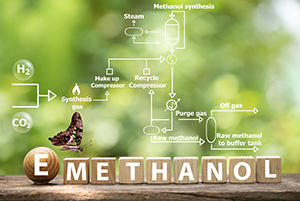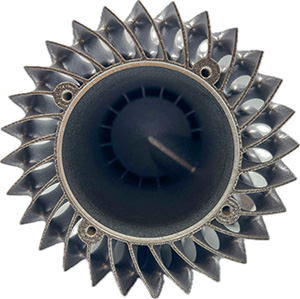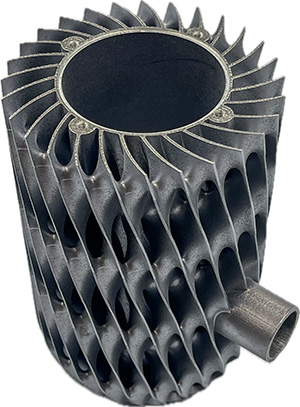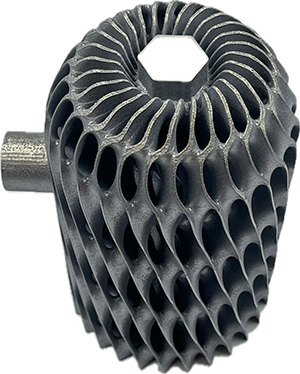
Enabling green methanol engines in cold climates: A 3D-printed solution for Heatflow
The Danish SME, Heatflow, has collaborated with additive manufacturing specialists at the Danish Technological Institute (DTI) to successfully demonstrate that it is possible to use metal 3D printing for a gas-to-gas heat exchanger. This was done in a Mission Booster project funded by Innovation Fund Denmark
In the race toward sustainable transportation, green methanol has emerged as a promising alternative fuel, particularly for heavy-duty applications like trucks and ships. However, a significant technical barrier has been hampering its  widespread adoption in northern Europe and other places with a similar climate: methanol engines simply won't start in cold temperatures.
widespread adoption in northern Europe and other places with a similar climate: methanol engines simply won't start in cold temperatures.
- These engines run well in the summer, but in winter they just won't start. This challenge has created a critical bottleneck for methanol adoption across Scandinavia and other cold-climate regions. Methanol vapours cannot ignite below 11°C, which means that a standard methanol engine is impossible to start up at colder ambient temperatures, explains Simon Brudler, AM specialist and senior consultant at DTI.
This limitation has created a geographical divide in green fuel adoption - while southern European regions can successfully implement methanol engines year-round, the technology remains inaccessible to northern markets where it is needed most for the green transition.
 Applying AM for compact performance
Applying AM for compact performance
In a Mission Booster project funded by Innovation Fund Denmark, the Danish provider of thermal solutions, Heatflow, and DTI set out to develop an innovative solution to this challenge: a compact, 3D-printed gas-to-gas heat exchanger that enables methanol engines to start reliably in sub-zero conditions.
The system works by incorporating a methanol burner that can operate at temperatures as low as -10°C. This burner preheats air through the specially designed heat exchanger, which in turn warms the engine sufficiently for reliable cold-weather starting.
- The 3D-printed heat exchanger reduced size and weight significantly and, after heat treatment, increased heat transfer efficiency by around 50%, which was key to achieving compact integration, says Paw V. Mortensen, CEO at Heatflow ApS.
Heatflow had previously demonstrated the working principle of such a heating system, but the original design was prohibitively large for practical engine integration, which is why 3D printing was chosen for an optimized version of the system.
- 3D printing is needed to make the system compact enough to actually pack into an engine. It is mainly about form factor - achieving the same performance in a much smaller space, says Simon Brudler.
The additive manufacturing approach offered several benefits:
- Pack maximum surface area into a minimal bounding box through complex internal geometries that are impossible to achieve with conventional manufacturing
- Create intricate gyroid structures that optimize heat transfer efficiency
- Rapidly iterate designs - the actual design and printing phase was completed in a very short period of time
- Achieve the right size for retrofitting in existing methanol engines
The project demonstrated that additive manufacturing enables a significantly more compact gas-to-gas heat exchanger, suitable for engine integration.
- Paw Mortensen, CEO, Heatflow ApS
Breaking new ground in gas-to-gas heat exchange
This project addressed a particularly challenging application in the additive manufacturing world: gas-to-gas heat exchangers. While most 3D-printed heat exchangers in the industry focus on liquid-to-liquid applications, this project demonstrates the viability of AM technology for gas-based thermal management systems.
 - We demonstrated the suitability of AM heat exchangers for gas-to-gas applications, highlighting how this opens doors for similar applications across various industries where gas-phase heat exchange is critical, says Ellen M.J. Hedegaard, AM business manager at DTI.
- We demonstrated the suitability of AM heat exchangers for gas-to-gas applications, highlighting how this opens doors for similar applications across various industries where gas-phase heat exchange is critical, says Ellen M.J. Hedegaard, AM business manager at DTI.
The final working prototype was 3D printed in aluminum to optimize weight while maintaining thermal performance. After printing, the project also had help from DTI’s specialists within green energy systems, who conducted comprehensive performance testing, thus validating the system's effectiveness in enabling cold-weather methanol engine operation.[PM3]
While the project focused on heavy-duty applications, Heatflow has since identified clear potential for adapting the preheater technology to maritime systems, where similar cold-start challenges exist. This will be explored in future development activities.
For Heatflow, the project delivered a validated proof-of-concept showing reliable cold-start functionality under lab conditions, confirming the technology’s potential for further scaling.
- The collaboration with DTI was decisive. They combined design-for-AM expertise with practical testing, enabling us to move from concept to validated prototype in less than a year, says Paw V. Mortsensen.
In addition to Heatflow and DTI, Alicon was also a partner and contributed with system specifications and integration requirements.
 Facts about the project – and looking beyond
Facts about the project – and looking beyond
The Mission Booster project resulted in a working prototype of the heat exchanger that was tested and verified in controlled environments. Next, Heatflow and DTI are exploring opportunities for further development through funded projects, as market demand for methanol engine solutions continues to grow.
For instance, the technology has international relevance in other cold-climate regions where similar challenges exist – e.g. China, where major automotive companies have been seeking solutions for methanol engine deployment in northern regions.
- This solution removes a key barrier for methanol engines in cold regions. With proven performance at -20°C, it enables e-methanol to become a viable fuel in both heavy transport and shipping, says Paw V. Mortensen.
For now, the successful combination of innovative thermal management design and advanced 3D printing capabilities demonstrates how additive manufacturing can solve specific, high-impact challenges in the green energy transition - turning promising sustainable technologies into practical, deployable solutions for cold-climate markets.
This represents an important step toward enabling green methanol operation in cold climates.
- Paw Mortensen, CEO, Heatflow ApS
In the video below, you can see a successful test run of the system from our specialists within green energy systems.